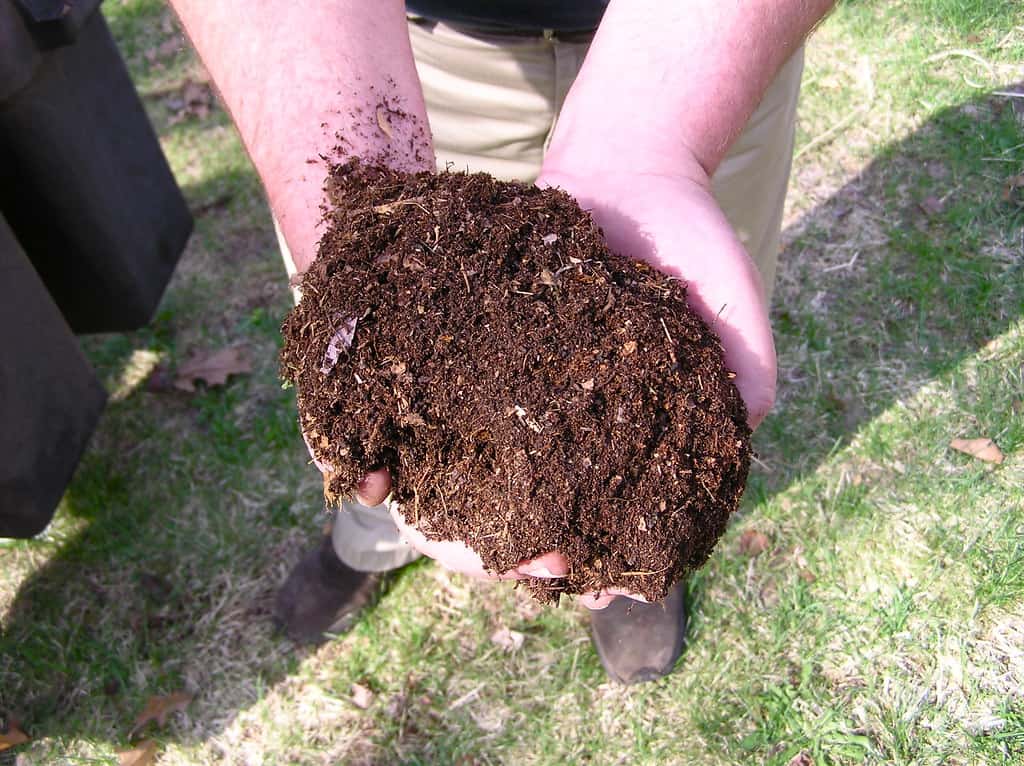A weed barrier will block grass under fence. Instead of repeatedly trimming or spraying the grass, you can enjoy a tidy look with little effort for years. Though plastic and rubber barriers are available, bricks and plant borders are more environmentally friendly.
Whether you have a white picket or chain-link fence, you probably wish it looked this tidy year-round:

JiminyPicketVinylFence.jpg by Deniseesser under a CC license.
But because a lawnmower can’t reach the grass underneath the fence, you either have to:
- Trim it with a different tool
- Place a barrier over it
- Tolerate it
In this article, I’ll explain how to keep grass from growing under fence with two barrier methods. These will give you a tidy look with little work in the long run.
Contents
Keep Grass From Growing Under Your Fence — Lay Bricks
This elegant solution is by Checking In With Chelsea:
What You’ll Need To Keep Grass From Growing Under Your Fence With Bricks
- Bricks of the same size
- String
- Stakes
- A square point shovel
- A hand trowel
- A rubber mallet
- A level
- A tape measure
- A hammer
- A brick chisel *
*Chelsea recommends breaking bricks in half with a cold chisel. However, Bob Vila states that brick chisels are specially made for this purpose.
How To Keep Grass From Growing Under Your Fence With Bricks – Step By Step
Here’s a step by step guide on how to use bricks to keep grass from growing under your fence:
- Measure Your Bricks
Use a tape measure to determine the length of your bricks.
- Set Stakes On Both Sides Of The Fence
The length of your fence determines how many stakes you should set. They need to be close enough that a string tied to two stays taut.
If your fence looks the same on both sides (like many wooden fences), place the stakes half a brick’s length from either side of the fence.
If your fence has back posts and a flat front, do the following:
1. From the front side of the fence, stick your tape measure underneath and have it grip the backside of a post.
2. Place a stake in the ground at one brick’s length from the back of the post.
3. Repeat for the other posts.
4. From the backside of the fence, align the stakes so that their strings will touch the back posts.
This will enable you to lay bricks flush with the back posts. - Tie Strings To The Stakes
Tie strings to the stakes, forming taut guidelines. Between lines on both sides of the fence, there should be exactly a brick’s length of space. - Dig A Trench
On each side of the fence, poke a square point shovel into the ground along each string. Dig a trench between the guidelines that’s about as deep as the height of a brick.
- Make Sure The Dirt Is Level
image credit: pixabay.com
Using a level and hand trowel, move dirt around until the trench is level. - Cut Some Bricks (If Applicable)
If your fence has back posts, you’ll need smaller bricks to lay against the posts. Use the tape measure to find a brick’s midway point. Split it there using a hammer and brick chisel. If you’re not sure how, see the video below.
- Lay The Bricks
Lay the bricks between the strings, making sure they’re all perfectly aligned. Use a level tool to make sure they’re level.
- Tap The Bricks
Tap the bricks with a rubber mallet to level them and push them into the ground.
- Fill The Gaps With Dirt
Fill the gaps between the bricks and surrounding earth with dirt. This will keep them from shifting out of place.
- When You Use Your Lawnmower, Roll Its Wheels On The Bricks
image credit: commons.wikimedia.org
Old lawnmower.JPG by ThorRune under a CC license
You can now cut the grass on either side of the fence.
For more great ideas by Checking In With Chelsea, check out her blog!
Video Tutorial: Cut A Brick In Half With A Hammer And Chisel
Not sure how to cut the bricks? Watch this demonstration by Do It All Dan:
Keep Grass From Growing Under Fence — Plant Liriope Muscari As A Border
Against a fence, a grass-like plant called liriope definitely looks better than overgrown turf grass. It’s also extremely low-maintenance, perennial, and doesn’t need to be mowed. Make sure you plant Liriope muscari, not Liriope spicata — the latter spreads quickly, making it unsuitable for borders.
Clemson Cooperative Extension states that most liriope varieties grow between 10 and 18 inches tall and that Liriope muscari typically grows 12 to 18 inches wide. Garden Down South recommends dividing liriope if it grows too large.
Liriope does best with a soil pH of 6.0 – 7.0. Most varieties grow well in shade, although some tolerate full sun. Liriope muscari grows best in Zones 5 – 10, although it may not survive winter in northern parts of Zone 5.
If the soil under your fence drains poorly, choose a different plant.
What You’ll Need To Keep Grass From Growing Under Your Fence By Planting Liriope Muscari As A Border
- A tape measure
- Some mature Liriope muscari plants
- Finished compost
- A shovel
- Pruning shears
How To Keep Grass From Growing Under Your Fence By Planting Liriope Muscari As A Border – Step By Step
Here are the steps on how to use Liriope Muscari as a border:
- Measure Your Fence
Clemson Cooperative Extension says to plant liriope one foot apart. Different varieties, however, may have different spacing requirements. If you buy new liriope plants, follow the spacing directions they come with.
Measure your fence to see how many plants you’ll need.
- Prepare The Soil

better compost by normanack under a CC license
Dig planting holes along the fence, either a foot apart or at the spacing recommendations for your Liriope muscari variety. Till the soil about six inches down and mix in some finished compost.
If the soil isn’t in the ideal pH range, amend it with your preferred method.
- Get Some Liriope Muscari Plants

Liriope muscari Lilac Beauty 0zz.jpg by David J. Stang under a CC license
The easiest way to propagate Liriope muscari is by dividing mature plants. If you don’t already have some, see if a neighbor does. You can also order Liriope muscari plants online.
Before propagating any plant asexually (such as by division or cuttings), make sure it isn’t patented.
- Dig Them Out Of The Ground (If Applicable)

If starting with established plants from a yard, dig one out of the ground. Be careful not to damage its roots. Don’t dig up any others until you’re sure you need them.
- Expose The Bare Roots

To separate the soil from the roots, knock the plant against something until the roots are exposed. Rinse them off with water.
- Divide The Roots

Pull the roots apart so you get several clumps. Grow New Plants demonstrates how:
If you have a difficult time with this step, Mike’s Backyard Nursery recommends cutting through the middle of the root mass with a soil knife.
- Plant The Divisions

Plant each division in a spot you prepared, being careful not to bury the root crown.
Gently water each plant to help the soil settle around its roots.
- Water Occasionally
Water your liriope occasionally. Wilson Bros Gardens says to keep the soil moist during the plants’ first growing season. Keep in mind that overwatering liriope can cause root rot and other diseases.
And That’s How To Keep Grass From Growing Under Fence!
The methods in this article may be time-consuming, but they’re also long-lasting and environmentally friendlier than plastic or rubber barriers. Once you’re done with either, you’ll no longer have to tolerate or trim unsightly grass under your fence.
Your lawnmower can easily roll over bricks or past liriope. If your region isn’t suitable for liriope, plant something else that is low maintenance and will hide weeds.
Did you enjoy this article on how to keep grass from growing under fence? If so, please share it! Please also share your thoughts in the comments.


 image credit:
image credit: 

